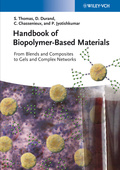Handbook of Biopolymer-Based Materials
From Blends and Composites to Gels and Complex Networks

1. Auflage April 2013
XIV, 974 Seiten, Hardcover
561 Abbildungen (230 Farbabbildungen)
28 Tabellen
Handbuch/Nachschlagewerk
Kurzbeschreibung
This first systematic reference on the topic discusses in two volumes the morphology, structure, dynamics, properties and applications of all important biopolymers, as well as their blends, composites, interpenetrating networks and gels.
Jetzt kaufen
Preis: 359,00 €
Preis inkl. MwSt, zzgl. Versand
Euro-Preise für Wiley-VCH- und Ernst & Sohn-Titel sind nur für Deutschland gültig. In EU-Ländern gilt die lokale Mehrwertsteuer. Portokosten werden berechnet.
- Gedruckte Ausgabe vergriffen -
This first systematic scientific reference in the area of micro- and nanostructured biopolymer systems discusses in two volumes the morphology, structure, dynamics, properties and applications of all important biopolymers, as well as their blends, composites, interpenetrating networks and gels.
Selected leading researchers from industry, academia, government and private research institutions around the globe comprehensively review recent accomplishments in the field. They examine the current state of the art, new challenges, and opportunities, discussing all
the synthetic routes to the generation of both micro- and nano-morphologies, as well as the synthesis, characterization and application of porous biopolymers.
An outstanding resource for anyone involved in the fi eld of eco-friendly biomaterials for advanced technologies.
BIOPOLYMERS: STATE OF THE ART, NEW CHALLENGES, AND OPPORTUNITIES
Introduction
Biopolymers: A Niche For Fundamental Research in Soft Matter Physics
Biopolymers: An Endless Source of Applications
Topics Covered by the Book
Conclusions
GENERAL OVERVIEW OF BIOPOLYMERS: STRUCTURE, PROPERTIES, AND APPLICATIONS
Introduction
Plant Cell Wall Polysaccharides
Biocomposites
Future Outlook
BIOPOLYMERS FROM PLANTS
Introduction
Lipid and Phenolic Biopolymers
Carbohydrate Biopolymers: Polysaccharides
Isoprene Biopolymers: Natural Rubber
Concluding Remarks
BACTERIAL BIOPOLYMERS AND GENETICALLY ENGINEERED BIOPOLYMERS FOR GEL SYSTEMS APPLICATION
Introduction
Microbial Polysaccharides as Biopolymers
Microbial Biopolymers as Drug Delivery Vehicle
Polyanhydrides
Recombinant Protein Polymer Production
Recombinant Genetically Engineered Biopolymer : Elastin
Collagen as an Ideal Biopolymer
Biopolymers for Gel System
Hydrogels of Biopolymers for Regenerative Medicine
Supermacroporous Cryogel Matrix from Biopolymers
Biopolymers Impact on Environment
Conclusion
BIOPOLYMERS FROM ANIMALS
Introduction
Chitin and Hyaluronic Acid in the Living World
Milestones in Chitin History
From Trehalose to Chitin
Chitin Synthase
Regulation of Chitin Synthesis in Fungi
Organization of Chitin in the Fungal Cell Wall
Organization of Chitin in the Arthropod Cuticle
Chitin-Organizing Factors
Secretion and Cuticle Formation
Transcriptional Regulation of Cuticle Production
Chitin Synthesis Inhibitors
Noncuticular Chitin in Insects
Chitin as a Structural Element
Application of Chitin
Conclusion
POLYMERIC BLENDS WITH BIOPOLYMERS
Introduction
Starch-Based Blends
Blends with Chitosan (One Amino Group Too Much . . . )
Future Perspectives
MACRO-, MICRO-, AND NANOCOMPOSITES BASED ON BIODEGRADABLE
POLYMERS
Introduction
Biodegradable Polymers
Biocomposites
Nanobiocomposites
IPNS DERIVED FROM BIOPOLYMERS
Introduction
Types of IPNs
IPNs Derived from Biopolymers
Manufacture of IPNs
Characterization of IPNs
Applications of IPNs
Conclusions
ASSOCIATING BIOPOLYMER SYSTEMS AND HYALURONATE BIOMATERIALS
Introduction
Synthesis and Self-Association of Hydrophobically Modified Derivatives of Chitosan and Hyaluronic Acid in Aqueous Solution
Design of Novel Biomaterials Based on Chemically Modified Derivatives of Hyaluronic Acid
Conclusions
POLYMER GELS FROM BIOPOLYMERS
Introduction
Experimental Methods
Polymerization and Gelation Kinetics
Sol?Gel Transition and Universality Discussion
Imprinting the Gels
Heterogeneity of Hydrogels
Ionic p-Type and n-Type Semiconducting Gels
Conclusions
CONFORMATION AND RHEOLOGY OF MICROBIAL EXOPOLYSACCHARIDES
Introduction
Conformation of Polysaccharides
Secondary Solid-State Structures for Microbial Polysaccharides
Conformation in Solution: Solution Properties and Applications
Gelling Properties in the Presence of Salts
Conclusions
SULFATED POLYSACCHARIDES IN THE CELL WALL OF RED MICROALGAE
Introduction
Sulfated Polysaccharides from Red Microalgae ? General Overview
Sulfated Polysaccharides of Red Microalgal Cell Walls: Chemical Aspects
Proteins in the Cell Wall of Red Microalgae
Rheology of Red Microalgal Polysaccharide Solutions
Modifications of the Sulfated Polysaccharides
Red Microalgal Sulfated Polysaccharide Bioactivities
VOLUME 2
DIELECTRIC SPECTROSCOPY AND THERMALLY STIMULATED CURRENT ANALYSIS OF BIOPOLYMER SYSTEMS
SOLID-STATE NMR SPECTROSCOPY OF BIOPOLYMERS
EPR SPECTROSCOPY OF BIOPOLYMERS
X-RAY PHOTOELECTRON SPECTROSCOPY: A TOOL FOR STUDYING BIOPOLYMERS
LIGHT-SCATTERING STUDIES OF BIOPOLYMER SYSTEMS
X-RAY SCATTERING AND DIFFRACTION OF BIOPOLYMERS
LARGE-SCALE STRUCTURAL CHARACTERIZATION OF BIOPOLYMER SYSTEMS BY SMALL-ANGLE NEUTRON SCATTERING
MICROSCOPY OF BIOPOLYMER SYSTEMS
RHEO-OPTICAL CHARACTERIZATION OF BIOPOLYMER SYSTEMS
RHEOLOGICAL BEHAVIOR OF BIOPOLYMER SYSTEMS
PHYSICAL GELS OF BIOPOLYMERS: STRUCTURE, RHEOLOGICAL AND GELATION PROPERTIES
INTERFACIAL PROPERTIES OF BIOPOLYMERS, EMULSIONS, AND EMULSIFIERS
MODELING AND SIMULATION OF BIOPOLYMER SYSTEMS
AGING AND BIODEGRADATION OF BIOCOMPOSITES
BIOPOLYMERS FOR HEALTH, FOOD, AND COSMETIC APPLICATIONS
INDE
alloys, and polymer recycling, has an h-index of 57 and has edited 23 books. Professor Thomas is also a Fellow of the Royal Society of Chemistry and a Fellow of the New York Academy of Sciences. His work has been awarded with the Professor Sukumar Maithy Award, the Bronze Medal of the Chemical Research Society of India (CRSI) and the Materials Research Society of India (MRSI) award, among others.
Dominique Durand is a Research Director Emeritus at the CNRS and former Director of the Polymers, Colloids and Interfaces Laboratory at the University of Maine, Le Mans (France). His research focuses on experimental studies and modeling of static and dynamic properties of complex systems, such as covalent networks, associating polymers and biopolymer gels. He is the author or co-author of over 210 research papers, reviews, and book chapters.
Christophe Chassenieux is a Professor at the University of Maine, Le Mans (France) since 2005, after being an Assistant Professor at the University Pierre et Marie Curie, Paris. His research interests encompass properties of polymer gels and self-assemblies of amphiphilic polymers. He is the co-author of 50 research articles, book chapters and patents.
Parameswaranpillai Jyotishkumar is DST INSPIRE Faculty at the Department of Polymer Science and Rubber Technology, Kerala (India). He has completed his PhD from Mahatma Gandhi University, Kottayam. Dr. Jyotishkumar's research focuses on polymer blends, nanocomposites, and bio-nanocomposites. He is the author or co-author of 30 research articles and book chapters.


